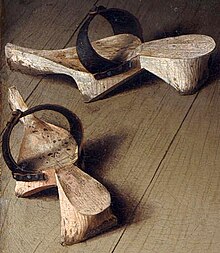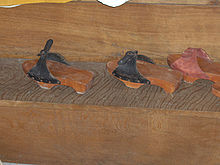Trippe



Trippen are lower shoes made of wood that were worn under normal shoes. Flaps are the equivalent of metal. In horses, too, wooden discs are strapped under the hooves as trippings.
Historical
In the Middle Ages were Heels not yet known. Trippen, for example, served as wooden undershoes that were strapped by the townspeople of that time under the sensitive reversible (beaked) shoes and other leather shoes. The reason for this was the largely unpaved streets and alleys in cities, which were heavily polluted by litter, animal droppings and other things. The rib comes just as the expression trippeln of frühnhd. tripping "walking, running". Tripps were also sometimes worn in the house to protect against cold feet in winter, for example from the cold stone floors. Later, from the 15th century until the 19th century, iron shoes (flaps) were also used to protect leather shoes from street dirt.
Alternatively, clogs were worn in some areas to protect against dirt . Tripping fell out of use due to the competition from galoshes and rubber boots on the one hand and the emergence of paved roads and street cleaning on the other.
Shoes with a similar purpose
Chopins
In the 15th century, the artistically crafted Chopins appeared in Spain, Italy and especially in women's fashion in Venice . Very high shoes, which were worn by patrician ladies as well as by successful courtesans, had the purpose of escaping the dirt on the street, but also to demonstrate status or eroticism.
Nalins
The Nalins known from the Ottoman Empire are optically similar to Trippen, but they are not undershoes. They were worn barefoot to protect the feet in Turkish baths from water and the heat of floors heated with hypocausts . They were also used z. B. when cleaning.
Geta
In ancient Japan, high-heeled wooden sandals were also used to keep the street dirt at bay. However, Geta is not about overshoes like the Trippen.
Horse ribs
Trippe is a wooden disc the size of a dinner plate and 5 cm thick, which was strapped under the hooves of workhorses in order to find a better grip on muddy surfaces, mainly in moorland .
See also
literature
- Francis Grew, Margrethe de Neergaard: Shoes and Pattens. Medieval Finds from Excavations in London . Museum of London (ed.). Boydell Press, 2004.
- Kai Niederhöfer: Medieval wooden ribs. Considerations on the meaning, chronology and typology . In: Itinera archaeologica. From the Neolithic to the early modern period . Festschrift for Torsten Capelle on his 65th birthday. International Archeology - Studia honoraria, Volume 22. Rahden / Westf. / Leidorf 2005, pp. 193-206.
Web links
- Two late medieval trips from Lüneburg. Instructive article of the city archeology of Lüneburg
- Two examples in the excavation dictionary
- Images of iron tripods from the early 15th century , Bavarian National Museum
- Trippchen, Germanisches Nationalmuseum, Nuremberg
- Children's patties from the 19th century
- Coat of arms of the no longer existing London guild of flap makers
- Turkish miniature from the Karlsruhe Turks' Booty , the women in the bathroom with Turkish patten
- Image by Nalins
- Image of Japanese patten
Individual evidence
- ↑ tripping. In: Jacob Grimm , Wilhelm Grimm (Hrsg.): German dictionary . 16 volumes in 32 sub-volumes, 1854–1960. S. Hirzel, Leipzig ( woerterbuchnetz.de ).
- ↑ to trip . Duden
- ^ Pfeifer in the DWDS
- ↑ Ashfield Metal Detecting Club , below the article Finding a Patten by John Gough
- ^ Trippen, early 15th century picture from the Bavarian National Museum
- ↑ Picture ( Memento of the original from April 9, 2010 in the Internet Archive ) Info: The archive link was inserted automatically and has not yet been checked. Please check the original and archive link according to the instructions and then remove this notice. at Gathering the Jewels
- ↑ Ashfield Metal Detecting Club , below the article Finding a Patten by John Gough
- ↑ Ashfield Metal Detecting Club , below the article Finding a Patten by John Gough
- ↑ metmuseum.org


